#gallienus
Explore tagged Tumblr posts
Text
Coin of the Day #262 (1/21/2025)
A cool historical piece showing that Valerian was still recognized as emperor for years after his capture by the Persians…


Roman Province - Bosporan Kingdom
BI Stater - 20mm 7.19g
Valerian, Gallienus, + Rhescuporis IV/V 263-264 AD
Kingdom of the Bosporus
Obverse BACIΛEΩC PHCKYΠOPIΔOC
Bust of Rhescuporis right, diademed, draped, trident right
Reverse ΞΦ
Busts of Valerian and Gallienus facing, laureate, draped, pellet between
RPC X 60028
#coin of the day#roman empire#roman province#kingdom of the bosporus#bosporan kingdom#valerian#gallienus#rhescuporis#roman coins#numismatics#coin#coins#ancient coins
8 notes
·
View notes
Text

Saint Zeno performs an exorcism on the emperor's daughter, bronze door, Basilica di San Zeno maggiore, Verona, ca 1140
16 notes
·
View notes
Photo

Postumus
Postumus was Roman emperor from 260 to 269 CE. Marcus Cassianus Latinius Postumus was a trusted military commander of Emperor Gallienus (253-268 CE) and governor or Germania Superior and Inferior (Upper and Lower Germany). After the death of his father Valerian in 260 CE, Gallienus left him in charge of military operations in the west. It was a mistake the inexperienced and trustworthy emperor would soon regret, for the commander's own troops would take advantage of Gallienus's absence to declare Postumus emperor. It was a move that allowed him to establish himself as the ruler of the Gallic Empire, which included Gaul, Spain, and eventually Britain.
Continue reading...
95 notes
·
View notes
Text

Gallienus (218–268 CE) was the 41st Emperor of Rome, ruling from 253 to 268 CE. During his reign, the Roman Empire faced lots of issues , including the loss of major provinces such as #Britain and #Gaul . which seceded under the leadership of the general #Postumus . #Gallienus attempted military reforms and fought against various usurpers but struggled to maintain control amid external invasions and internal revolts. His reign ended when he was assassinated by his own officers during a siege in #Milan .
Gallienus issued a variety of coins during his reign, primarily the billon antoninianus. These coins often featured his portrait and various deities, serving as both currency and propaganda to bolster troop morale. The imperial mint followed Gallienus during military campaigns to produce necessary coins, depicting themes of victory and celebrating military achievements. Notably, about 40 rare gold coins of Gallienus were discovered in the #Lava_Treasure in #Corsica in the 1980s, highlighting his monetary legacy.
#archaeology #ancient #ancienthistory #museum #numismatics #numismatist #numismatica #rarecoins #oldcoins #worldcoins
#coincollecting #coincollection #gold #metaldetecting #silvercoins
#coin #romancoin #ancientcoins #ancientgreekcoins #money #history.
#temple#art #greece #alsadeekalsadouk #الصديق_الصدوق
4 notes
·
View notes
Text

Silver coin of the Roman emperor Gallienus, minted at Rome and dating to his sole reign from 260 to 268 CE. On the obverse, the radiate bust of Gallienus; on the reverse, the personification of Laetitia (Happiness) with the inscription LAETITIA AUG(USTI). Found in Surrey, England, UK; now in the British Museum. Photo credit: The Portable Antiquities Scheme/The Trustees of the British Museum.
#classics#tagamemnon#Ancient Rome#Roman Empire#ancient history#Roman history#Gallienus#art#art history#ancient art#Roman art#Ancient Roman art#Roman Imperial art#coins#ancient coins#Roman coins#Ancient Roman coins#numismatics#ancient numismatics#metalwork#silver#silverwork#British Museum
38 notes
·
View notes
Text
Maximinus Dia, Maxentius, Maximian, I had forgotten how much I hated the age of Diocletian.
#and then you have to avoid confusion with the Thracian soldier-emperor from a century ago#sorta like how with the Constantinians theres Constantine III randomly in the 5th century. no he's not one of them.#THIS is why people hate late antiquity#if you thought gallienus and galerius were hard to tell apart...#roman history
0 notes
Text

Zenobia of Palmyra was known as the «Warrior Queen of the East»
According to the Historia Augusta, Zenobia was: “wise in counsel, tenacious in planning, firm with soldiers, generous and harsh when necessary.” “She rode a horse and walked with her soldiers for three or four miles.” She was cultured and erudite. In addition to her native Palmyrene Aramaic, she was fluent in Latin, Greek and Egyptian Aramaic. Palmyra is the name given by the Romans to Tadmor, an ancient city located in the Syrian desert, in present-day Homs province.
Zenobia was the second wife of one of Rome's allied kings, Septimius Odaenathus. When the Persian king captured and executed the Emperor Valerian around 260, Odaenathus aligned himself with Valerian's son and successor, Gallienus. After defeating the Sassanid Empire of Persia, favoring Roman interests, King Odenathus brought Palmyra to unprecedented power.

But around 267 Odaenathus was assassinated along with his eldest son, Hairan, son by his first wife. Zenobia's cousin Maeonius was accused and she sentenced him to death. Zenobia succeeded her husband and ruled Palmyra as regent; her son, Vaballathus, was 1 year old.
After consolidating her control over Palmyra and its surrounding territories, she launched a series of military campaigns . Zenobia and her army, with general Zabdas, conquered Egypt. The Roman prefect of Egypt, Probus Tenaginus, and his soldiers attempted to drive them out, but Zenobia's army captured and beheaded Probus. Zenobia declared herself queen of Egypt and minted coins in her name.
At that time, her kingdom extended from the Nile to the Euphrates.
Aurelian, who had ascended the throne in 270, was determined to restore order to the Roman Empire, which had been in chaos for nearly 40 years. After pacifying the western borders (the so-called barbarians had been raiding for decades), he began a campaign against Zenobia, culminating in the siege of Palmyra in 272 ; according to Roman historians, this campaign was the most difficult that Aurelian had to face during his entire reign.

'Queen Zenobia Addressing Her Soldiers' (1730) by Giovanni Battista Tiepolo
The Roman army marched on Palmyra, where Zenobia held out. According to the Historia Augusta, Aurelian offered Zenobia terms of surrender but she escaped to seek support; she was captured before crossing the Euphrates and Palmyra's brief empire came to an end.

'Queen Zenobia's Last Look Upon Palmyra' by Herbert Gustave Schmalz, 1888. This painting shows Zenobia, handcuffed in gold, looking imposing; the painter represents her as a warrior displeased at having lost her kingdom - instead of showing her crying or looking at the ground - and the Roman soldier who escorts her, coming down the stairs, looking at her thoughtfully.
According to Trebellius Pollio, Zenobia was taken to Rome in Aurelian's triumphal procession in 274. And according to the Greek historian Zosimus, her son, then eight years old, died during the journey to Rome. But Zenobia's ultimate fate remains uncertain; some sources claim she was executed; Other sources claim that Aurelian ordered her to be escorted to a villa near Hadrian's Villa, where she spent the rest of her life.
In Roman chronicles, she was portrayed as an ambitious and dangerous queen but also as worthy of admiration for her bravery and political skills.
In Syria, Zenobia became a national and patriotic symbol.


Roman theatre in Palmyra


World Heritage Site
159 notes
·
View notes
Text
Coins of the Deified Augustus, 14-268 CE
The most fascinating thing about these types is how Augustus's portrait changes with the engraving style of the period as his portrait is sort of fused with that of the current emperor.

Divus Augustus Dupondius, struck under Tiberius. A pretty much unaltered portrait of Augustus, something we won't be seeing often when it comes to these coins. Struck 22-23.

Divus Augustus under Tiberius, laureate head of Tiberius on obverse, laureate head of Augustus on reverse with star above. Struck 14-16.
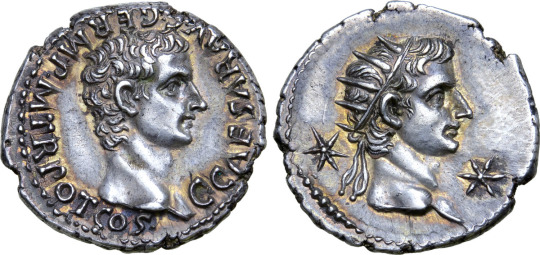
Divus Augustus under Caligula, struck 37. Bare head of Caligula right on obverse, Radiate head of Augustus right on reverse, two stars to each side of bust.

Divus Augustus, struck in Spain(?) during the civil wars that took place between 68 and 69. Radiate head of Augustus on obverse. Pax standing left and holding a caduceus on reverse.
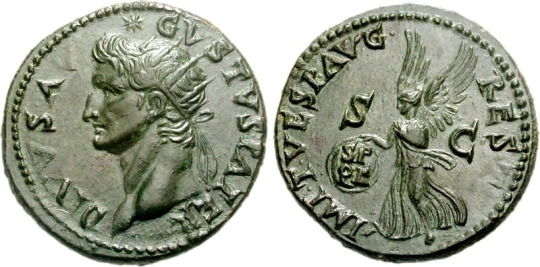
Divus Augustus under Titus (restitution issue that takes the design of that Tiberius Dupondius). Struck 80-81.
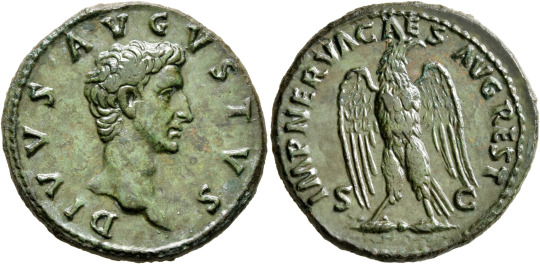
Divus Augustus As issued under Nerva (kind of a restitution issue, but not really) Struck 97-98. Eagle perched on thunderbolt on reverse.
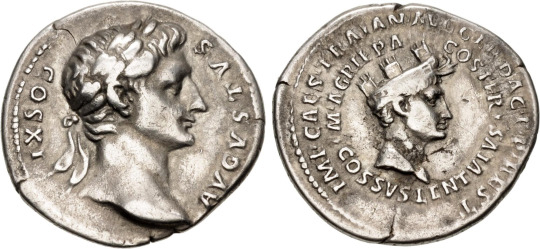
Under Trajan, another restoration issue of one of Augustus's denarii and technically not a Divus issue but I'm still putting here because I like it. Struck 107 or 112-113
Reverse depicts his bestie Agrippa
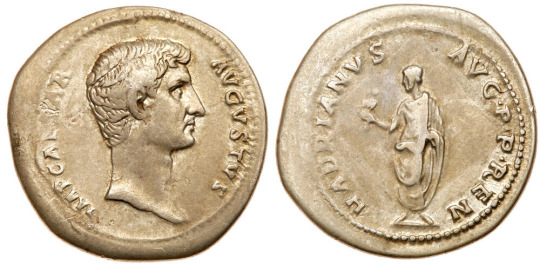
Cistophoric Tetradrachm struck under Hadrian, 128 (Augustus is literally just a beardless Hadrian here) Reverse depicts Hadrian holding some corn ears.
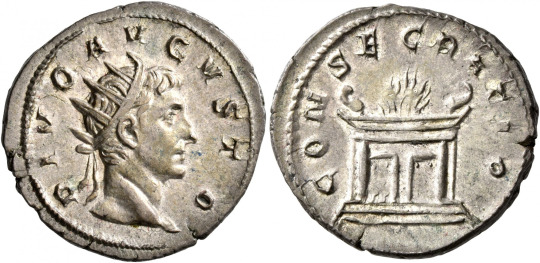
Skipping forward quite a bit, Divus Augustus Antoninianus issued under Trajan Decius as a part of his "Divus" series of coins. Reverse depicts a lit altar. Struck 249-251.
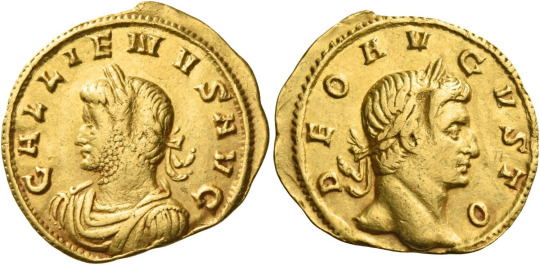
Deo Augusto issue, this one is really interesting as it is *theorized* that this was struck as a way to ask for aid from Augustus the god during Gallienus's disastrous reign. Struck 260-268.
#ancient coins#ancient rome#ancient art#ancient history#roman art#history#roman coin#roman coins#roman empire#roman emperor
183 notes
·
View notes
Text

The Aldobrandini Wedding is a 1st century BCE fresco discovered in 1604. It was found near the ceiling of a house near the Arch of Gallienus on the Esquiline Hill in Rome. It is currently housed in the Vatican Museum.
15 notes
·
View notes
Photo

Gallien
Gallien fut empereur romain de 253 à 268 de notre ère. Publius Licinius Egnatius Gallienus, fils aîné de l'empereur Valérien, fut nommé co-empereur par son père en 253 de notre ère. Il fut l'un des nombreux prétendants au trône au cours des deux décennies suivantes. Pendant 50 ans, de 235 à 285 de notre ère, plus de 50 prétendants à la pourpre impériale de Rome se succédèrent. Le fait d'être empereur de l'Empire romain n'apportait pas toujours la sécurité de l'emploi. En 253 de notre ère, après seulement trois mois sur le trône, l'empereur Émilien se préparait à affronter son challenger, Publius Licinius Valerianus (Valérien). Malheureusement, avant même qu'il ne pose le pied sur le champ de bataille, sa propre armée se rebella et l'assassina; c'est cette même armée qui l'avait récemment déclaré empereur. Avec le soutien des deux armées et du Sénat romain, Valérien fut déclaré nouvel empereur.
Lire la suite...
2 notes
·
View notes
Text
Titus Fulvius Junius Quietus (died 261) was a Roman usurper (individuals or groups of individuals who obtained or tried to obtain power by force and without legitimate legal authority) against Roman Emperor Gallienus.
Was a roman senator
Served during the rule of emperor Commodus, who is known for his erratic behavior and autocratic style
Likely belonged to the prominent Fulvia family, known for producing numerous senators and public officials
There are very few specific details about his life, actions, career and is not a central figure in historical texts.
0 notes
Text
Coin of the Day #160 (10/11/2024)
Another nice provincial…


Roman Province - Syria
AE25 - 12.00g
Gallienus 253-268 AD
Damascus Mint
Obverse IMP CAES P LIC GALLIENVS P F AVG
Bust of Gallienus right, laureate, draped, cuirassed, from front
Reverse COL ΔAMAS METRO
Prize crown between two purses on table with curved legs, rams head below
RPC X 63767
#coin of the day#roman empire#roman province#ancient rome#gallienus#damascus#syria#roman coins#coin#coins#numismatics#ancient coins
6 notes
·
View notes
Text

Roman, Bust of a bearded man (so-called Gallienus), 3rd c. a.d. x
0 notes
Photo
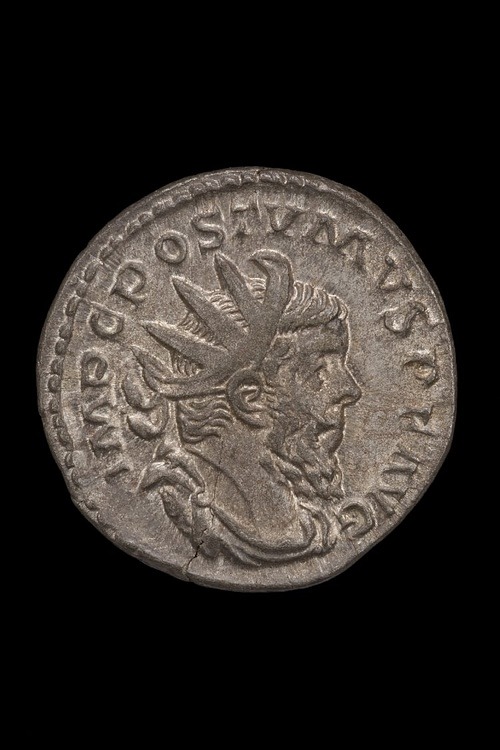
Postumus
Postumus was Roman emperor from 260 to 269 CE. Marcus Cassianus Latinius Postumus was a trusted military commander of Emperor Gallienus (253-268 CE) and governor or Germania Superior and Inferior (Upper and Lower Germany). After the death of his father Valerian in 260 CE, Gallienus left him in charge of military operations in the west. It was a mistake the inexperienced and trustworthy emperor would soon regret, for the commander's own troops would take advantage of Gallienus's absence to declare Postumus emperor. It was a move that allowed him to establish himself as the ruler of the Gallic Empire, which included Gaul, Spain, and eventually Britain.
Rise to Power
Marcus Cassianus Latinius Postumus was an opportunist. While fighting the Persian King Shapur in the east, Emperor Valerian has been captured while attempting to negotiate peace and eventually died while in captivity, even suffering the humiliation as serving as the king's footstool. His unexpected death led to a crisis in the empire, for many inside and outside of Rome did not believe his co-emperor and son Gallienus was capable of managing the vast empire. Although he struggled to maintain his right to the throne and restore order, there was resistance.
From 235 to 285 CE, there were at least fifty claimants to the throne, and only one would die of natural causes, Claudius Gothicus. The Pax Romana, initiated by Augustus, was long over. In 260 CE Postumus would not be the only one to oppose the recognized emperor. Much of the resistance to Gallienus was in the east. For the next two years, there were at least seven pretenders to the purple. First, like so often before, after a successful victory, a commander would be declared emperor by his own troops. This time is was Ingenuus. Unfortunately, he would neither be recognized in Rome nor even step foot in the city; he was defeated by the Roman commander Aureolus at Mursa. While some speculate he was killed by his devoted troops as he fled the battle scene, others believe he committed suicide to avoid capture.
Ingenuus' once dedicated army quickly switched their allegiance to Regalianus, the governor of Upper Pannonia. Again, this supposed reign was short-lived. He was overcome by Gallienus, and like so many others, allegedly killed by those who had initially supported him. With the urging of their father, two more emerged to claim the throne, the brothers Macrianus and Quietus. In 261 CE Macrianus and his army advanced into the Balkans only to meet Roman forces and be severely defeated. Quietus, who had remained in Syria, was routed at Emesa where the townspeople turned on him and put the would-be emperor to death.
Continue reading...
44 notes
·
View notes
Text

Marble bust of the Roman emperor Gallienus (co-emperor with his father Valerian 253-260, sole emperor 260-268 CE)
0 notes
Text
*look up how young this guy was when he was made emperor - he should have been at the club daycare
0 notes